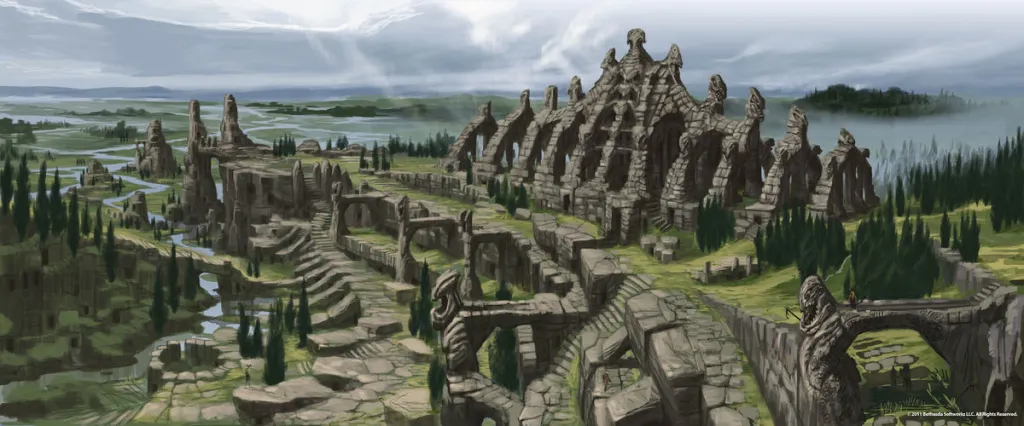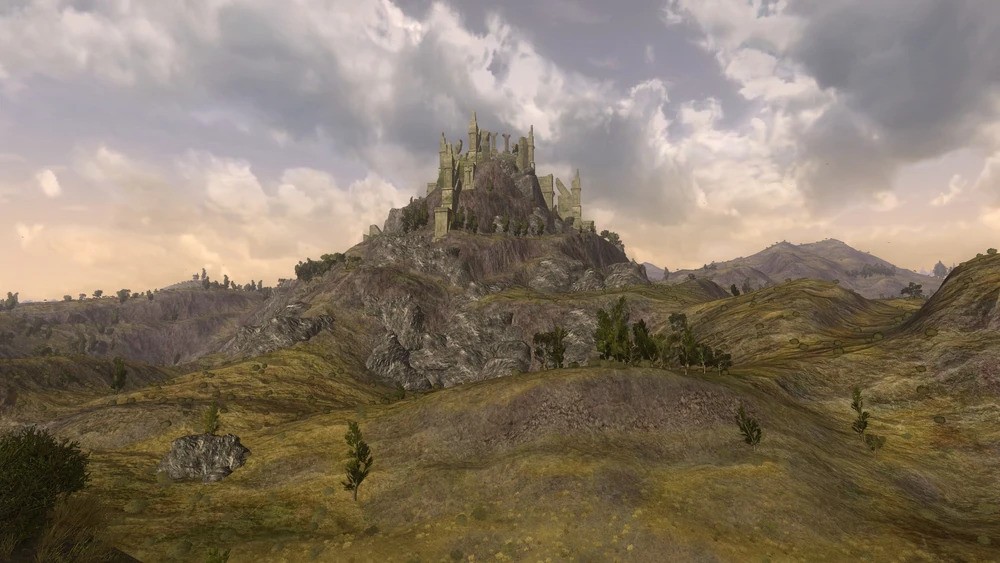Leon Corneille-Cowell
Department of Archaeology, University of York, York, UK.
Email: leoncowell96 (at) gmail (dot) com
Tolkien scholarship is defined as the study of J.R.R. Tolkien’s personal life, legendarium, or academic work. This is a multidisciplinary area of study encompassing subjects such as literature, linguistics, and gender studies. There are several peer-reviewed journals for Tolkien studies including Mallorn by the Tolkien Society, Tolkien Studies, and Journal of Tolkien Research (Brennan Croft, 2016).
Tolkien himself was an academic, working at the University of Leeds and Pembroke College, Oxford. His research specialised in Anglo-Saxon Literature and Philology. Furthermore, one could argue that fantasy literature and archaeology have an intrinsic link, ruins of lost civilisations and magic items – in fact, the author of the Malazan Books of the Fallen, Steven Erikson, was an archaeologist before beginning his literary career (Fantasy Book Review, 2023).
Despite the seemingly obvious connection to the ancient world, very little has been published in the way of archaeological research or interpretations of the world of Middle-earth. Some may argue this to be impossible; however, Tolkien wrote a magical world and mythos which was full of references from human history and prehistory.
This article aims to examine occurrences of archaeology and archaeological techniques in the world of Middle-earth and demonstrate how archaeological methodology can be used in fantasy literature.
THE RUINS
When one thinks of Archaeology as a discipline people often imagine ruins and standing stones; this idea harkens back to the grand tour of the post-medieval period (Ceserani et al., 2017). In the Narrative, we encounter two main ruins, those of Weathertop and Osgiliath (Tolkien, 2004: 163, 664). Sabo (2007) notes ruins as part of Tolkien’s rich cultural landscape and places of memory.

In the case of Weathertop, it is a memory of a fallen kingdom that only a small few (the Dúnedain) can remember. At one point Aragorn (a bearer of cultural burden) educates the hobbits on this fact. Though the idea of the Lost Kingdom sounds fantastical during the tumultuous early medieval kingdom, it was a reality (Williams, 2023). Lost Kingdoms are a reality in Tolkien’s legendarium with the city of Gondolin bearing resemblance to Babylon and the tower of Babel (Garth, 2020: 150).
On the other hand, the ruins of Osgiliath are a city of the extant kingdom of Gondor. Though still associated with what is lost, they are much more focused on a kingdom in decline, like the Roman or Byzantine empires (Norwich, 1996). Furthermore, the statues of Gondor’s founding father that the party encounters harken back to the statue of the classical and Egyptian civilisations such as those described in Ozymandias by P.B. Shelley (Garth, 2020: 143).
OBJECT BIOGRAPHIES
Object biographies are the study of an item’s ‘life’ going from its ‘birth’ or creation to its ‘death’ or destruction and in some cases it’s ‘rebirth’ or remaking. The idea dates to Kopytoff (1986) and is a way of examining relationships between people and materials as well as spatial relationships with the landscape (Gosden & Marshall, 1999). In Middle-earth there are several object biographies that can be explored. Middle-earth is based on a fantastical prehistory of Earth (Tolkien et al., 2006); thus, all objects would be considered artefacts by modern archaeologists and scholars – for the purpose of this paper we have selected only the objects with significance to the plot.
The Ring
The most obvious biography is an item central to the plot, namely the One Ring (also called the Ruling Ring and Isildur’s Bane). The plot of The Lord of the Rings follows a journey, not just of the characters but also of the Ring itself. We are given the Ring’s biography with its creation in Mount Doom, its acquisition, and then subsequent loss by Isildur, and then its discovery and loss by Smeagol (Gollum) in chapter three Of Shadows of the Past (Tolkien, 2004 [original publication from 1954–1955]: 53–56). The biography of the ring is followed in detail during Tolkien’s first publication, The Hobbit [1937]. The One Ring is unusual as an object as Tolkien describes it as having malice and even leaving Gollum (Tolkien, 2004: 53; Day, 2020), suggesting a level of personhood in the object, which is unusual for an object biography.

Anduril
Anduril, the sword of Aragorn, is introduced in the chapter The Council of Rivendell and is made up of the reforged fragments of Narsil. The sword was forged by a Dwarven smith before being taken by the Númenóreans, when it fell into the possession of Elendil. The sword was then shattered during the battle with Sauron, but the shards were used to kill Sauron by Isildur.
In the Narrative, the sword plays a huge role in Aragorn’s identity as King of Gondor; he uses it to identify himself and his heritage to Éomer and the other riders of Rohan. Swords are shown as identifiers of kingship and warriorhood and heritage in early medieval literature. Examples include Excalibur in the tales of Arthur and the sword of Wiglaf in Beowulf as opposed to the ‘Foreign’ weapons such as the spear Gáe Bulga of Cúchulainn (Sayer et al., 2019: 544–545). Sayer et al. (2019) attribute a person-like quality to swords, which in burials are not worn like knives (an indication of utilitarian purpose) but indicates them to be a symbol of masculinity and power.
FUNERARY ARCHAEOLOGY
Funerary Archaeology or Archaeothanatology is the study of mortuary rites, burial practice, and death in an archaeological context (Cooney, 2023). This can relate to anything from grave goods and the landscape of burial to osteological studies of the dead (Stutz & Tarlow, 2013). In The Lord of the Rings, there are two instances where funerary archaeological comparisons can be made: the appearance of the Barrow Wight in Fog in the Barrow-Downs and the dead men of Dunharrow in The Passing of the Grey Company (Tolkien, 2004: 135, 773).

The Barrow Wight and Barrows
Fog in the Barrow-Downs describes an encounter Frodo, Samwise, Pippin and Merry have with an undead creature residing in a Barrow Grave (Tolkien, 2004: 135–148). Here we see Tolkien’s early medieval literary origins with the creature resembling that of a draugr from Scandinavian folklore (Chadwick, 1946). Archaeological evidence for the undead in the real world often comprises measures to stop the undead; potential examples of this include cut and burn marks on an assemblage of skeletons found at Wharram Percy, Yorkshire (Mays et al., 2017). Similarly, there are examples of ‘Vampire’ burials in Poland, though in Tolkien’s legendarium a vampire is a distinctly separate creature from a wight (Betsinger & Scott, 2014). The restless dead are also found in the ‘Dead Marshes’ though this bears more resemblance to no man’s land in the Somme, an unlikely type of funerary archaeology (Garth, 2020: 165).
Barrows are a common burial practice which dates independently from the Bronze Age, Iron Age, and Early Medieval period (Grinsell ,1984; Noort, 1993; Garrow et al., 2014; Cooney, 2023; Stephens, 2023: 19–20). Barrows are shown again outside the city of Edoras in Rohan; it is a commonly held consensus that the Rohirrim are modelled on the Anglo-Saxons (Bates, 2002; Sabo, 2007: 102). So, it is likely that the Barrows were built in the manner of those in early Medieval England (Noort, 1993). However, the context of burial outside of a settlement resembles that of the Romans (Zachos & Karampa, 2015). In the text it says: “At the foot of the hill the way ran under the shadow of many mounds, high and green”, “Seven mounds upon the left, and nine upon the right said Aragorn ‘Many long lives of men it is since the golden hall was built” (Tolkien, 2004: 507).
The Anglo-Saxon comparison is further emphasised by the burial of Théoden’s horse, Snowmane, after his demise alongside his master during the Battle of the Pelennor Fields (Sabo, 2007: 104). Horse burials have been found alongside numerous Anglo-Saxon “warrior” graves (Cross, 2011). Horse burials have been found in other sites such as the Chariot Burials of Iron Age East Yorkshire (Stephens 2023).
This contrasts to the description of the Barrow-Downs, which are described differently and in a much more sinister light: “he turned his glance eastwards and saw that on that side the hills were higher and looked down upon them; and all those hills were crowned with green mounds, and on some were standing stones, pointing like jagged teeth out of green gums” (Tolkien, 2004: 137). The difference in description may be due to the Rohirrim mounds being that of honoured dead who represent the culture’s proud warrior heritage and identity. Whereas the inclusion of standing stones in the Barrow-Downs bears more resemblance to the prehistoric passage tombs from the Neolithic and Bronze Age (Grinsell, 1984: 17; Cooney, 2023: 200). Furthermore, the hobbits fear the barrows, they are ‘other’ and outside of the hobbit’s cultural memory, like the attitude of later cultures to the Neolithic stones at Avebury (Gillings & Pollard, 1999: 186).
The hobbits also awaken covered in jewels and swords, like those found at Sutton Hoo – excavated around a similar time to the writing of The Lord of the Rings; connections to Beowulf have also been made, which was a work Tolkien famously translated and published (Lindqvist, 1948). The hobbits are gifted swords and find out the barrows belonged to the Men of Westernesse – who were beaten by the kingdom of Angmar. These men were descended from the Númenóreans, a thalassocracy bearing similarity to the Bronze Age Minoans (Williams, 2020). Here we also see the object biographies of these objects, which are brought back from “death” by the characters using them; one of those swords goes on to help kill the Witch-king of Angmar, fulfilling its purpose symbolically.
The Dead Men of Dunharrow
The Dead Men of Dunharrow (also known simply as Oathbreakers) first appear in the chapter The Passing of the Grey Company (Tolkien, 2004: 773). In Appendix F, Tolkien notes them as being kin to the wild men of Drúadan Forest who moved to the mountains and became the men of the mountains (Tolkien, 2004: 1025). These men are described as Pre-Númenóreans, or the indigenous men of Middle-earth, and included the Hill-men and Dunlendings. Comparisons can be found between these groups and Iron Age tribes who lived in Britain when the Romans first arrived; albeit in a rather dated and Roman depiction of them as “savage”.
The Dead Men are an unusual depiction of funerary archaeology as no bodies are ever shown. Instead, they appear as wraiths, the unrestful dead. This is due to their breaking of an oath and past worship of Sauron. Breaking of Oaths is a common trope in ancient literature and appears many times in Tolkien’s narrative, such as Saruman betraying Gandalf and breaking the law of hospitality, a tradition dating back to Homer (Sinex, 2003; Pitt-Rivers, 2012).
CONCLUSION
In conclusion, we have given a brief outline of archaeology in the worlds and imagination of Tolkien. Toilkien’s engagement with the past and classical texts, as well as with archaeological discoveries from his time (Sutton Hoo), is self-evident from his writing and imagery. However, this article aims to highlight how more recent and specialised archaeological areas of study can be applied to Tolkien. Namely, this was done with object biographies and funerary archaeology. We found that Tolkien’s rich descriptive prose allows for interpretation of the physical, allowing for easy cultural comparisons to be found.
REFERENCES
Bates, B. (2002) The Real Middle Earth. Sidgwick & Jackson, Basingstoke & Oxford.
Betsinger, T.K. & Scott, A.B. (2014) Governing from the grave: vampire burials and social order in post-medieval Poland. Cambridge Archaeological Journal 24(3): 467–476.
Brennan Croft, J. (2016) Bibliographic resources for literature searches on J.R.R. Tolkien. Journal of Tolkien Research 3(1): a2.
Ceserani, G.; Caviglia, G.; Coleman, N.; De Armond, T.; et al. (2017) British travelers in eighteenth-century Italy: the grand tour and the profession of architecture. The American Historical Review 122(2): 425–450.
Chadwick, N.K. (1946) Norse Ghosts (a study in the Draugr and the Haugbúi). Folklore 57(2): 50–65.
Cooney, G. (2023) Death in Irish Prehistory. Royal Irish Academy, Dublin.
Cross, P.J. (2011) Horse burial in first millennium AD Britain: issues of interpretation. European Journal of Archaeology 14(1-2): 190–209.
Day, D. (2020). Ring Legends of Tolkien. London: Simon and Schuster.
Fantasy Book Review. (2023) Steven Erikson Biography. Available from: https://www.fantasybookreview.co.uk/Steven-Erikson/biography.html (Date of access: 22/Nov/2023).
Garrow, D.; Meadows, J.; Evans, C.; Tabor, J. (2014) Dating the dead: a high-resolution radiocarbon chronology of burial within an early Bronze Age barrow cemetery at Over, Cambridgeshire. Proceedings of the Prehistoric Society 80: 207–236.
Gillings, M. & Pollard, J. (1999) Non‐portable stone artefacts and contexts of meaning: the tale of Grey Wether. World Archaeology 31(2): 179–193.
Gosden, C. & Marshall, Y. (1999) The cultural biography of objects. World Archaeology: 31(2): 169–178.
Grinsell, L.V. (1984) Barrows in England and Wales. Bloomsbury Shire Publications, London.
Lindqvist, S. (1948) Sutton Hoo and Beowulf. Antiquity 22(87): 131–140.
LOTR Fandom. (2000) The One Wiki to Rule Them All. Available from: https://lotr.fandom.com/wiki/Main_Page (Date of access: 28/Jan/2024).
Mays, S.; Fryer, R.; Pike, A.W.G.; Cooper, M.J.; Marshall, P. (2017) A multidisciplinary study of a burnt and mutilated assemblage of human remains from a deserted mediaeval village in England. Journal of Archaeological Science: Reports 16: 441–455.
Noort, R.V.D. (1993) The context of early medieval barrows in Western Europe. Antiquity 67(254): 66–73.
Norwich, J.J. (1996) Byzantium: The Decline and Fall. Knopf Publishing Group, New York.
Pitt-Rivers, J. (2012) The Law of Hospitality. Journal of Ethnographic Theory 2(11): 501–517.
Sabo, D.L. (2007) Archaeology and the sense of history in J.R.R. Tolkien’s Middle-earth. Mythlore 26(1): a7.
Sayer, D.; Sebo, E.; Hughes, K. (2019). A double-edged sword: swords, bodies, and personhood in early medieval archaeology and literature. European Journal of Archaeology 22(4): 542–566.
Sinex, M.A. (2003). “Oathbreakers, Why Have Ye come?”: Tolkien’s ‘Passing of the Grey Company’ and the twelfth century Exercitus Mortuorum. In: Chance, J. (Ed.) Tolkien the Medievalist. Routledge, London. Pp.155–168.
Stephens, M. (2023) Chariots, Swords and Spears. Oxbow Books, Oxford.
Stutz, L.N. & Tarlow, S. (2013) Beautiful things and bones of desire: emerging issues in the archaeology of death and burial. In: Stulz, L.N. & Tarlow, S. (Eds.) The Oxford Handbook of Death and Burial. Oxford University Press, Oxford.
Tolkien Gateway. (2023) Oathbreakers. Available from: https://tolkiengateway.net/wiki/Oathbreakers (Date of access: 28/Jan/2024).
Tolkien, J.R.R. (2004) [1954–1955] The Lord of the Rings. 2nd Ed. Harper Collins, London.
Tolkien, J.R.R.; Carpenter, H.; Tolkien, C. (2006) The letters of J.R.R. Tolkien. Harper Collins, London.
Williams, H. (2020) Tolkien’s thalassocracy and Ancient Greek seafaring people. Tolkien Studies 17: 137–162.
Williams, T. (2023) Lost Realms: Histories of Britain from the Romans to the Vikings. William Collins, Glasgow.
Zachos, K.L. & Karampa, M. (2015) The Cemeteries of Nicopolis. The Hellenic Ministry of Culture, Athens.
About the author
Leon Corneille-Cowell is a Bsc student in archaeology at the University of York as well as an avid Tolkien fan who reads the Trilogy once per year. He is starting a MSc in Funerary Archaeology in September 2024. It is his personal ambition to be a Tolkien scholar and contribute archaeologically to the field of Tolkien studies



